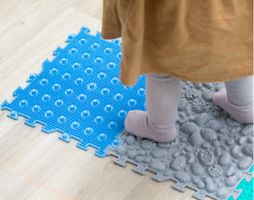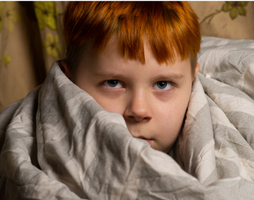Sensory Regulation
Case Studies
Acknowledgements
This work has been made possible by an award from Postcode Community Trust, a grant-giving charity funded entirely by players of People’s Postcode Lottery. Our thanks also to the staff, parents and children who took part in this project. All names have been changed to protect confidentiality.
The 'teeter popper'
We had been working with a little 7-year-old boy, M, for a few sessions. This session was the first time we had taken him outdoors to do some of the activities. He taken part in some of the activities and enjoyed them, even though at first he was a bit anxious and was afraid that the hammock wouldn’t hold his weight. He then did go into the hammock and loved it, he felt ‘Just Right’ and looked quite relaxed – he was smiling away. He was so content that he even asked his little friend to join him in the hammock.
At the end of the session it was time for the nurture activity and a Scared Gang story (see Project Description). He would only have Milky Bar yoghurts (he is diagnosed with ASD) and we had got some of these especially for him. He was learning to suck the yogurt through a straw as this can be very soothing and regulating. He was still struggling with this new way of doing things.He enjoyed eating the first one using a spoon and kept asking his friend of he wanted the second yoghurt as it was meant for him. M clearly wanted it! As his friend didn’t want it I said that M could have it. He had stood up and was reluctant to let me help him – all signs that he was starting to get more heightened/agitated. As he was pulling the lid off he spilt the yogurt on the floor. He was clearly devastated at losing his beloved yogurt. The support staff with him were telling him to clean it up. He was saying ‘no, no’ and he seemed embarrassed at having spilt it.
I offered to help him to clean it up and he said he was going to “use my thing to help me “and went to the ‘teeter popper’ and used it to help himself to regulate. Staff said that normally this would have led to a big outburst. Prior to the start of the project this child was ‘totally losing it’ in class, throwing chairs, and other similar behaviours. Since working with the Adenydd Team he had no major outbursts at all!
The peanut ball and a little girl
One afternoon we had taken a peanut ball into Flying Start to show them some regulating activities they could use with the children. Staff starting tapping the end of the ball in front of a little girl who has an Autism SPectrum Condition, is non verbal, avoidant of interaction with staff and usually only engages in solitary play. When staff stopped tapping the little girl took the staff's hands and placed then onto the ball for her to do it again.
They played like this for a few minutes with the little girl interacting with the staff.
Staff were then able to encourage her to sit on the ball this progressed to her holding staff's hands and rocking gently back and forth on the ball whilst staff sung 'Row, Row, Row your Boat'.
She was squealing, laughing and making some eye contact. Staff were able to video some of this activity to show mum . Mum was delighted and has bought her a peanut ball to play on at home.
"Just Right and Just Better"
A little boy in the Nursery class really enjoyed and responded to the nurture, story and snack time at the end of the session.
We had introduced the concept of feeling ‘just right’ in our bodies with Our Just Right story designed by an Adenydd Associate.
After hearing the story for a few times he said that he felt “Just right and just better!”.
Emotions hard to recognise
Nursery child, Jeremiah, had attended for a few sessions . Staff were saying he was struggling in class to recognise his emotions and feeling.
During our session where he had been doing a sensory walk he suddenly announced that “someone was kicking him inside his chest “.
He was not distressed and he was able to expect our explanation that it was his heart beating faster to let him know its enjoying the activities he was doing.
He liked this explanation.
The Magic Blanket
Jatinda had been upset and agitated prior to the session . He had been throwing objects and running around the play area. He remained heightened as he entered the session so we asked if had like to be swung in a blanket.
Once we started swinging he curled up into the foetal position and started to make cooing and baby sounds. Staff then sung Rock a bye baby to him and he settled and became very relaxed. Following the swinging we encouraged him to snuggle up in a bean bag with a blanket and he ate two frubes through a straw. Staff commented that this was “the most settled “ she had seen him. He was able then able to participate in the remainder of the session.
The Hammock Experience
We’d been working with Talia for two weeks when we did our first session outdoors. We had a few different hammocks and swings for the children to explore. Talia loved the hammock.
They asked staff if they could have some strawberries and a smoothie in the hammock . They appeared completely relaxed and had a huge smile on their face. He said they “felt like a prince”.
Reparing a connection
Trevor is an 8 year-old boy who had been very withdrawn and unhappy since starting at the school two months ago. He was clingy to one staff member and staff they struggled to talk and engage with him and he particularly struggled to remain in his seat during lessons.
Trevor had been extremely reluctant to join the session and had asked if he could go back to class several times whilst walking to the session area. Although reluctant and suspicious of us he did start to join in and enjoy the activities. We had made a sensory walk / circuit and by the end of the session support staff said they had “never seen him so relaxed and happy. Ive never seen such a smile“.
Staff were observed swinging Trevor in the 'nest' swing on the yard to “calm him" following lunch time play.








